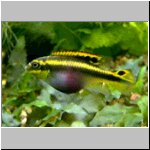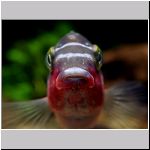Index |
Articles |
Krib Updated during June, 2024. |
Warning! This article includes personal opinions and speculations!
|
Pelvicachromis pulcher (Boulenger, 1901) |
Krib Kribensis Kribensis cichlid Common krib Rainbow krib Red krib Super-red krib Pink kribensis cichlid Palette cichlid Rainbow cichlid Purple cichlid King cichlid |
West Africa |
|
Pelmatochromis pulcher Pelmatochromis aureocephalus Misspelled synonym: |
Palett Palettciklid Vanlig palett Vanlig palettciklid Röd palett Röd palettciklid |
 Photo (Female) |
 Photo (Male) |
 Photo (Group) |
|
The krib (Pelvicachromis pulcher) is a species of The krib is a very popular species to keep as a freshwater aquarium fish.
There are several variants of the krib in the aquarium hobby/industry.
Since 2013, the genus Pelvicachromis has eight scientifically described species. However, there are, presumably, several undescribed species, and/or undescribed subspecies, in addition to the described species. Some of the other species of Pelvicachromis may look confusingly similar to the krib. Sometimes, they may also be called one of the same common names, or a similar name, as the krib. There are also a few species of other genera, that may be confused with Pelvicachromis. To alleviate confusion when refering to a specific fish, you may want to include the scientific name, origin history and what variant it is presumed to be, if such information is available and seems reliable. To determine the gender of a krib may be tricky, if it is a juvenile, but it is easy if it is an adult fish.
The males grow to about ten cm (about four inches) standard lenght.
A male has a more elongated body shape and the pelvic fins,
anal fin and dorsal fin are each extended into a slender fine point.
As the male gets older, the caudal fin takes on a spade/flame/diamond shape.
The dorsal fin is also, usually, prominently colored all the way to the extended point on the male,
making the back end tip of the dorsal fin a good place to start,
when trying to determine the gender, unless the krib has been The females grow to about six cm (about 2.4 inches) standard lenght.
Males of common red and super-red color varieties of kribs get deep red coloration on the belly.
Sometimes, that red color extends forwards to the mouth of the male, unlike the females.
On the females, the red remains focused on the round belly,
with the option to Kribs eat most normal types of aquarium fish foods being offered.
During the spawning preparations and parental care, the kribs can dig a bit, but seldom destroy plants.
I have bred kribs many times. Kribs are cave breeders. Half coconut shells, or ceramic flowerpots, are examples of objects that, with some modfication, may become suitable breeding caves. The male occupies a territory with a breeding cave.
Usually, Adult dominant female kribs are, in my opinion, usually, slightly more strongly colored than males. This is somewhat rather rare among fishes. However, there are several different color breeding varieties and a few natural color/location varieties, of the krib, in the aquarium hobby/trade. The color comparison between males and females does not always hold true, especially when comparing individual kribs from different varieties, or different levels of age development, or different mood, or from different tanks with different colored substrate etc. When a lonely adult female krib feels excited, she may try to get a dominant male's attention,
by swimming, dancing and vibrating to show her colorful bulging belly.
The female gets deeply red When a male and female has formed a pair, they will improve their cave by digging, to make it more suitable for them. The female is the most active one, during the spawning, when the eggs are laid on the ceiling inside of the cave. Eggs and fry are furiously guarded by the female. The wrigglers hatch from the eggs after two to three days. The wrigglers become free swimming fry about four days later. The fry can eat artemia nauplii as their first food. Normally, the fry stay with their parents for about a month, until they have become juveniles and are able to make it on their own. If the pair bonding is harmonious and strong, the male and female will help eachother with doing all parts of the parental care. They will take turns, to closely guard the offspring, versus going out alone to find food, or to patrol the territory. If the pair continue to get along, the male also continue helping with the guarding of the wrigglers and fry, including occasionally helping to move them using his mouth, if needed, just like the female does with her mouth, if needed. Either one of the parents can use his, or her, mouth to either move the wrigglers (or freeswimming fry) to a new location and spit them out there, or to pick upp stragglers among the offspring who may have ventured away a bit too far (from the others), and then spit them back into the center of the swarm/herd. This also goes for those fry who are not keeping up fast enough with the others during a move, when the parents are herding the offspring around the territory. The fry will try to following various directions from their parents. The parents use various signs, such as twitching of the body, flaring fins, and/or changing intensity of their colors, to make the fry do different things, such as gather around the parent, or to hide at the bottom, or to signal that it is safe to graze/forage for food. The parents also have ways to instruct the fry to stay and not follow them, if they want to gently slip away when taking turns to guard the fry, or when they urgently need to deal with an potential intruder in the territory. However, the male, generally, spends more time to take care of the outer defence than she does. He tries to keep all intruders away from the territory. When needed, the female also helps to guard the territory and they sometimes work together to intimidate, and/or attack, potential intruders, to chase them away, or simply show a display of combined force to keep other fishes, including other pairs of kribs (from neighboring territories), at bay. When a bonded pair of kribs is facing off against another pair of bonded kribs in a normal ritual territory dispute, right at the location of the territory border, they, usually, squabble male versus male and female versus female. If you choose to take away the fry for artificial raising,
there's a risk that the male will come into spawning mood again, before the female does.
The percentage of males and females in the batches highly depends on the pH value. Under pH seven, there will be more females and over pH seven there will be more males (on average). If you want to get a lot of fry, you can breed the krib in a separate breeding aquarium, maybe with a few appropriately chosen dither fish, so that the parents have something to aim their aggression towards, if needed. (Dither fish may help to prevent kribs, or other pair bonding cichlids that you want to breed, from aiming too much aggression towards eachother, which is a risk, if they have no other distractions and nowhere else to aim their aggression.) With some kribs, there is also an other eventuality that may happen, if the initial pair bonding is weak instead of harmonious. (I have not noticed this with the kribs that I've kept myself, but have seen and heard of a few occasions, when it has happened to some kribs owned by other people.) After the spawn, there is a possibility that the female may furiously chase away the male, if she decides to not let him participate in any of the close/inner guarding and defence of the offspring. However, she may, or may not, still rely on him to guard the outer territory? I don't know if different strategies regarding parental care behaviour is highly related to certain local populations of kribs in the wild, but I guess some of the different populations may have evolved to use different strategies. I also don't know, but suspect, it may, perhaps, be related to fishkeepers raising krib fry without their krib parents in captivity, for many generations, without prioritizing their inherited parental instincts/skills and pair bonding instincts/skills at all? Either way, to me personally, it seems a bit disturbing and sad when I hear about, or watch videos, about any kribs that do not form a strong pair bond and do not successfully cooperate to raise their young. This is only my personal feelings about the situation and I'm aware that I'm partially anthropomorphizing the kribs, but to me, comparing their behaviors to human behaviours is a great part the thrill of keeping them. Everyday, when I was young, I watched my own colony of kribs, as a part of my daily life routine. I raised many generations of strongly bonded kribs, in aquariums that I used to keep in my bedroom, before I started keeping my aquariums in a separated "fishroom" in a basement. Strategies without strong long term monogamous pairbonding are very common and natural, among other genera of dwarf cichlids, such as Apistogramma. I just happen to prefer to see the "harmonious way" of pair bonding when it comes to the krib. Personally, I think it is very fascinating and interesting to observe several strongly monogamously bonded pairs of kribs, interacting together in a large community aquarium, to let them practise their natural territory squabbles, dominance displays, courtship and other breeding behaviours and parental care behaviours, as they vigorously protect and raise their offspring. If you raise kribs and they do not show a strong pair bond, especially if they seem very "dysfunctional" and "defective" in their parental behaviour, no matter how beautiful they may be regarding color and bodyshape, I recommend switching them out for a new colony of kribs from another hopefully "better" source. You are seriously missing out on so much excitement and amazing natural wonder, if you do not experience keeping kribs with fully developed type of pair bonding. If you breed/sell/distribute kribs from a breeding line with a record of great parental care, I believe it also helps other fishkeepers to have a better chance of getting hold of "behaviorally" high quality kribs. Related external links and references:
|
[ Species Articles ]
Index
E-mail Max Strandberg